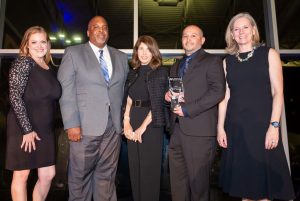
VRX accepts a 2022 CMAA North Texas Project Achievement Award for US 281 Segment 1. The project won in the “Transportation over $200M” category. Accepting the award on behalf of VRX are Utility Engineering Task Leader Jon King, PE (second from left), VRX President Noelle Ibrahim, PE (middle), and US 281 Segment 1 Resident Engineer Carlos Ayala, PE (second from right).
VRX is honored to have been recognized with a 2022 CMAA North Texas Project Achievement Award for our comprehensive construction management, construction inspection, utility engineering, and environmental services on US 281 Segment 1. Our project won in CMAA North Texas’ “Transportation over $200M” category.
US 281 Segment 1 is a complex heavy highway project with a construction value of $215M located in the Recharge Zone of the Edwards Aquifer. At the time of its letting in 2017, the 4-mile US 281 Segment 1 was the largest bid-build project in TxDOT San Antonio history. The existing four-lane highway had been a two-way super street configuration (SSC), and the SSC had been in place about 10 years.
The reconstruction included three-lane northbound and southbound frontage roads, new highway with two general-purpose lanes in each direction, and one HOV lane in each direction. This was the first HOV lane implementation in San Antonio.
The US 281 Segment 1 project also constructed four new direct connectors (DCs) at Loop 1604 and US 281, and it added one direct T-ramp connection to a new VIA Park & Ride facility at Stone Oak Parkway. A total of 19 bridges were constructed, including the four DCs, which completed the north half of the four-level Loop 1604 and US 281 Interchange. The bridges were composed of steel girders and concrete beams. Elevated construction to build the DCs was up to ~100 feet in the air.
US 281 Segment 1 had a complex traffic control plan (TCP), more than 100 traffic switches, 273K SY of concrete pavement, and 45 retaining walls (RW), including MSE, cast-in-place, soil/rock nail, and H-pile shafts. This is a heavily traveled corridor with daily commuter traffic congestion. Inspections included a diverse group with specialty inspections, structural, ITS, traffic signals, and specialty illumination.

VRX won a 2022 CMAA North Texas Project Achievement Award for US 281 Segment 1 in San Antonio. We won in the “Transportation over $200M” category.
This project was also the largest joint bid utility venture in TxDOT history. As the prime CM firm, VRX, Inc., ensured stringent coordination with AT&T, CPS, and SAWS. Communication was vital to the success of this project. We closely monitored the budget along with unforeseen issues, errors/omissions and we communicated about added work to each utility for approval before beginning the work. In addition, our team kept in contact with more than three dozen homeowners’ associations (HOAs) who were extremely interested in project progress.
Leave a Reply